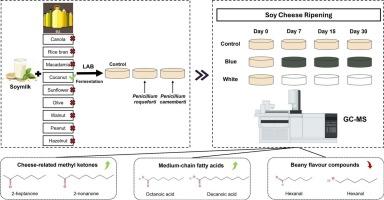在霉菌成熟的大豆奶酪中增强乳制品的香味,减少豆味
IF 5.2
1区 农林科学
Q1 FOOD SCIENCE & TECHNOLOGY
International journal of food microbiology
Pub Date : 2025-08-26
DOI:10.1016/j.ijfoodmicro.2025.111408
引用次数: 0
摘要
以植物为基础的奶酪替代品通常缺乏传统乳制品奶酪所具有的令人满意的奶酪风味。这项研究的目的是开发以大豆为基础的奶酪,其风味可与蓝色和白色霉菌成熟的乳制品奶酪相媲美,如洛克福奶酪和卡门贝尔奶酪。对用洛克福青霉和卡门培青霉发酵的豆浆中挥发性化合物进行了分析。然而,这些发酵没有产生关键的酮味化合物,如2-庚酮和2-壬酮,可能是由于在普通豆浆中缺乏中链脂肪酸前体。为了解决这一问题,我们筛选了9种植物油,并确定椰子油是唯一支持青霉菌生产甲基酮的来源。添加椰子油的霉菌成熟大豆奶酪释放的甲基酮含量明显较高,与乳制品中的甲基酮含量密切相关。此外,已醛和已醇等浓味化合物也被霉菌代谢大量减少。主成分分析结果表明,罗queforti成熟的大豆奶酪与商业蓝白霉菌成熟的乳制品奶酪具有聚类性,而camemberti成熟的大豆奶酪具有更明显的挥发性特征。这些发现强调了底物组成的重要性,特别是脂质类型,在提高大豆基奶酪的风味发展。本文章由计算机程序翻译,如有差异,请以英文原文为准。

Enhancing dairy-like aromas and reducing beany flavours in mould-ripened soy cheeses
Plant-based cheese alternatives often lack desirable cheese-like flavours characteristics of traditional dairy cheeses. This study aimed to develop soy-based cheeses with flavour profiles comparable to blue and white mould-ripened dairy cheeses, such as Roquefort and Camembert. Volatile compound profiles were analysed from soymilk fermented with Penicillium roqueforti or Penicillium camemberti. However, these fermentations failed to produce key ketone flavour compounds, such as 2-heptanone and 2-nonanone, likely due to the absence of medium-chain fatty acid precursors in plain soymilk. To address this, nine plant-based oils were screened, and coconut oil was identified as the only source that supported methyl ketone production by Penicillium spp. Mould-ripened soy cheeses supplemented with coconut oil released significantly higher levels of methyl ketones, closely matching those in dairy counterparts. In addition, beany flavour compounds such as hexanal and hexanol were substantially reduced by mould metabolism. Principal component analysis showed clustering of P. roqueforti-ripened soy cheese with commercial blue and white mould-ripened dairy cheeses, whereas P. camemberti-ripened soy cheese had a more distinct volatile profile. These findings underscore the importance of substrate composition, particularly the lipid type, in enhancing flavour development in soy-based cheeses.
求助全文
通过发布文献求助,成功后即可免费获取论文全文。
去求助
来源期刊
CiteScore
10.40
自引率
5.60%
发文量
322
审稿时长
65 days
期刊介绍:
The International Journal of Food Microbiology publishes papers dealing with all aspects of food microbiology. Articles must present information that is novel, has high impact and interest, and is of high scientific quality. They should provide scientific or technological advancement in the specific field of interest of the journal and enhance its strong international reputation. Preliminary or confirmatory results as well as contributions not strictly related to food microbiology will not be considered for publication.

 求助内容:
求助内容: 应助结果提醒方式:
应助结果提醒方式:


